Cerro Torre - South east ridge
Vía del Compresor (Compressor Route)
Ezio Alimonta, Carlo Claus and Cesare Maestri (Italy), 2/12/1970 to 60 meters from the summit. Steve Brewer and Jim Bridwell (USA) 4/1/1979 to the summit.
Description. Using a gas powered air compressor Maestri drilled close to 400 bolts, avoiding natural features and forcing his way upward. In 2012 close to half of those bolts were removed, making the route unclimbable in its original form (see the Filo Surteste route for a description of the climb that follows the natural line up the SE ridge). See lower down a section regarding the bolt removal.
History. To understand the Compressor Route properly, it’s important to comprehend Maestri’s motivation for establishing the climb. In early 1970, after another unsuccessful attempt on the mountain’s west face, the Italian mountaineer Carlo Mauri sent a telegram back home, saying, “We return safe and sound from the impossible Cerro Torre.” This message, published in one of Italy’s biggest newspapers, Corrière, was aimed at Maestri, who claimed, and still claims, to have reached the summit by the east and north sides in 1959. This was the first time that anyone publicly expressed doubts in Italy about the 1959 claim. Immediately Maestri decided to return to Cerro Torre, explaining in his book Duemilla Metri della Nostra Vita, “I return and attack their routes, the routes they were not able to climb. I will humiliate them, and they will feel ashamed of having doubted me.”
[The best analysis of Maestri's motivation is Reinhold Messner's book Torre-Schrei aus Stein published in 2009 in German by Piper Verlag and in Italian under the title Grido di Pietra by Corbaccio.]
As part of his “vengeance” Maestri decided to attempt the route in the winter. He used a helicopter to carry equipment to the base of the peak, including a 180kg air compressor, and a wooden hut that was placed on the glacier near the base. Alimonta, Claus and Maestri spent 54 days working on the route in harsh winter conditions, and after climbing 600 meters they gave up. Also part of the expedition were C. Fava, R. Valentini and P. Vidi. They returned a few months later, in Spring, with a larger team that also included D. Angeli, C. Baldessari, F. Barozzi and J. Spickerman.
On this occasion Maestri stopped some 60 meters below the summit, close to the end of the headwall, but still on vertical ground. He dismissed the final ice and snow commenting: “It's just a lump of ice, not really part of the mountain, it will blow away one of these days.” Regarding Maestri’s high-point, Bridwell commented, “Looking up I saw seven broken bolts leading up and slightly right, but 25 meters of blank granite stretched between the last bolt and the summit snow. My God, I thought, Maestri must have nailed 25 meters of ice tenuously bound to smooth rock. It was a bad joke, and inconsistent with the magazine articles” (Climbing 58 p. 24-28).
Before retreating, and as a “coup de grace” to his “masterpiece”, Maestri decided to remove all the bolts, but he gave up after chopping just a handful. To climb those last 35 vertical meters, and to complete the first ascent of the route Bridwell, and Brewer, placed a number of rivets, pitons and copperheads. Theirs was the third ascent of the mountain, after the Ragni and American teams, both via the west face and was carried out in three days round trip. Bridwell wrote about their ascent: “I like to think that if you are not scared, you are not having fun; and, if that’s true, the Cerro Torre is worth a couple of years in Disneyland.”
Regarding Maestri's “It's just a lump of ice, not really part of the mountain, it will blow away one of these days.” comment, John Bragg (USA), who did the second ascent of Cerro Torre (after the Ragni’s first) and Torre Egger’s first ascent commented, “I find rather silly the fact that many climbers feel to have climbed Cerro Torre despite not having ascended the final mushroom. This kind of thinking seems all too common in Patagonia: from Maestri’s famous comments after his 1971 bolt route to an early ascent claim of Standhardt in 1978. Perhaps this is because the last few feet of these mountains can be so devilish difficult. Whatever the reason, the definition of summit is quite clear. You either reach it or you don’t”. Climbing 187 p. 12, p.15).
The SE ridge was first attempted in early 1968 by an Anglo-Argentine including team Martin Boysen, Mick Burke, Pete Crew, Jose Luis Fonrouge and Dougal Haston (see Filo Surteste route).
Controversy. The Compressor Route caused and still causes much controversy in mountaineering circles, because of the use of the gas powered air compressor and the number of bolts placed. In several hundred-meter long sections Maestri ignored the natural features, bolting blank rock alongside. He drilled the 90-meter traverse because he found the Anglo-Argentine line blocked by rime. Higher up, on the Ice Towers, he bolted a blank pillar next to an ice chimney, simply because he wasn’t a keen ice-climber. Commenting on the 250-meter long bolt ladder on the headwall, Maestri said they could have climbed much of it using pitons but having left most of them at the bergschrund, they were forced to drill their way up. Perhaps more puzzling than Maestri’s tactics was the fact that hundreds of alpinists eagerly followed his footsteps. American alpinist Jim Donini famously called it the "world's hardest via ferrata."
Bolt removal. There are key questions regarding the 2012 bolt removal. Should an overwhelmingly manufactured path be in place to facilitate the ascent of such an spectacular and naturally difficult peak. If we accept such a pathway, because some of us, who wouldn’t otherwise have the necessary skills to climb the peak, might enjoy reaching the summit, then it could be argued that the mountain should be made accessible to those who don’t climb at all. Has alpinism come to the point where reaching a summit without actually engaging the difficulties of the mountain is considered virtuous and spiritually fulfilling?
Can a route that so blatantly compromises the wildness of a mountain and the core values of alpinism be considered a cultural asset worth preserving? Maestri’s odyssey was an historic event, but should the mountains become a giant open-air museum, displaying all the old bolts, fixed ropes and wall trash of significant ascents? Is the preservation, in situ, of these vestiges of human passage more valuable than the preservation of wildness? Humans have been able to correct the negative effects of other historic events: dams are removed from rivers and creeks; land is rehabilitated where quarries and mines once stood; colonial flags were taken down from the Argentine government buildings. And yet history with all its glory and its lessons survives.
A few climbs in the Italian Dolomites, the so-called Direttissimas, contain as many or more holes per meter, and they were put up in a style somewhat reminiscent to that of the Compressor Route. However, the Direttissimas were established long after the first ascents of all the obvious natural lines up a face or peak, and unlike the Compressor Route, they represented an evolution of sorts in the search for virgin terrain. Routes with a considerable amount of drilling in places like Yosemite are also not comparable to the Compressor Route: they used bolts to connect natural features rather than to avoid them. Also one should note that neither these routes nor the Direttissimas are the normal—easiest—route up a peak, let alone to an iconic, freestanding summit. Therefore, they don’t alter drastically the character of a whole peak as the Compressor Route did.
And why should the default setting be to leave a contentious installation, rather than remove it? The latter is far closer to the original, non-controversial state. Are the need for vengeance by one climber, Maestri and the complacency of hundreds of repeat ascensionists strong enough arguments for preserving such a severe disfigurement to a mountain as grand as Cerro Torre?
Ultimately, climbers will remain divided over whether the route was a cultural asset worth preserving or whether the mountain is an icon of wilderness adventure and a natural monument worth recuperating.
Support for the bolt removal.
Close to one hundred climbers that were instrumental in the development of the area, accomplishing many of the most influencial climbs, signed a petition in support of the bolt removal. The petition can be found here.
At a 3/2012 meeting of the British Mountaineering Council International Committee the following statement was agreed upon: "The BMC International Committee supports Traditional Ethics in mountaineering and supports the removal of the Maestri bolts from Cerro Torre." See the full letter here.
Yvon Chouinard's thoughts on the bolt removal here.
At the 2013 Piolets d'Or event Kennedy and Kruk were awarded a "Special Mention" for the de-bolting of the Compressor Route. The Jury was composed by Stephen Venables, Silvo Karo, Gerlinde Kaltenbrunner and Jumbo Yokoyama. The jury felt that ‘by drilling bolts on Cerro Torre, Cesare Maestri stole the future from the next generation.’ Jury member Silvo Karo, with outstanding new routes of his own on Cerro Torre was especially keen that the actions of Kruk and Kennedy in stripping Maestri’s bolts ‘should be applauded.’
The press release about this Piolet d'Or "Special Mention" expressed the following thoughts: "The bolts blinded possibilities: by returning Cerro Torre to a more natural state those blinders have been removed, as witnessed by the countless teams that climbed the west face this year. It turns out that the physical presence of the bolts was not nearly as important as their psychological impact, and their tendency to focus attention on the manufactured path, rather than on the mountain's natural features that allow passage. Maestri’s odyssey and the Compressor Route will live on in history books as a testament to man's potential for hubris and incredible drive, while Cerro Torre has recovered its standing as an icon of wilderness adventure. The events on Cerro Torre in 2012 forced us to take a close look at the core values of alpinism. As Reinhold Messner explains, it is time to “leave behind the chains of conquest alpinism ...and search again for the limits of possibility—for we must have such limits if we are going to use the virtue of courage to approach them.” When asked about the Compressor Route, the legendary Slovene climber Silvo Karo, responsible for two new routes and one major link up on Cerro Torre, responded, “That climb was stolen from the future. Without all those bolts the history of that marvellous mountain would have been very different. I am convinced that in alpinism how you have climbed is more important than what you have climbed.” Jury president Stephen Venables expressed similar thoughts, saying "over the last 20 years climbing has become more and more a 'consumer' product, where you simply pay to receive a pre-packaged predictable experience. Kennedy, Kruk, Lama and Ortner have restored Cerro Torre's southeast ridge to the realm of genuine adventure. My feeling is that this goes way beyond Cerro Torre. The relentless increase in bolting of every lump of rock in the world is seriously undermining the most basic values of mountaineering". The full press release can be read here.
Winter ascent. Paolo Caruso, Maurizio Giarolli, Andrea Sarchi and Ermanno Salvaterra, (Italy), 3-8/7/1985. First and only winter ascent of the peak. They spent a total of 11 days in the mountain, from the glacier back to the glacier. Alimonta, Claus, Fava, Maestri, Valentini and Vidi had made a winter attempt in 1970 (see above). Giuliano Giongo and Bruno De Donà made another in 1983. In July of 1999, climbing via the west face, Swiss Thomas Ulrich, Stefan Siegrist and David Fasel, with American Greg Crouch reached the summit plateau, at the base of a final 8 meter tall summit mushroom. Support for the removal of the Compressor route bolts.
At a March 21st meeting of the British Mountaineering Council International Committee the following statement was agreed upon: The BMC International Committee supports Traditional Ethics in mountaineering and supports the removal of the Maestri bolts from Cerro Torre. See the full letter here.
Solo ascents. The first confirmed (see later) solo ascent of the mountain was done by Swiss Marco Pedrini the 26/11/1985. Marco, who was 24 years old at the time, did the approach with two Swiss friends, then up the first three pitches -some of the hardest of the route free climbing wise- jumared fixed ropes he found, then climbed without a rope until the last rock pitch, commonly known as the “Bridwell” pitch. He reached the summit in under thirteen hours from the col of Patience. In the following few weeks he re-climbed the route with cameraman and climber Fulvio Mariani to film a reconstruction of the solo ascent for the Swiss/Italian television, reaching the summit at least two more times. The resulting documentary, “Cumbre”, is likely one of the best mountain films ever made. Marco who was one of the leading alpinists in the 1980’s, was found dead at the base of the west face of the Dru a few months after his Torre ascent. Apparently he fell to his death when his rappel anchor pulled while descending after yet another bold solo ascent, this time of the “American Direct”.
This route was first attempted solo by Bill Denz (New Zealand) who in two occasions reached a high point some 70 meters below the summit (7 and 11/11/1980), both times being forced to retreat due to bad weather. He took down the compressor’s carburetor as a proof of his attempts, on one of which he was stuck for five days in the ice towers waiting out a storm to then fall 250 meters on the lower mixed terrain during the descent, a fall that he survived almost unscratched, with a wrenched shoulder and a great fright. He did not intend to climb alone, but he was forced to do so when his partner Charlie Porter did not show up. Bill was NZ’s best mountaineer at the time, and had done impressive ascents in Alaska and Himalaya on top of his many achievements in the Southern Alps. An avalanche killed him in 1983 while attempting to climb Makalu.
Frenchman Pierre Paul Farges made a solo attempt in March of 1983, but was found dead near the base of Cerro Torre, one week after leaving basecamp. He had attempted the route earlier, in late in 1982 with Guy Abert and Thierry Volpiatto, but after Abert left to work and he had a disagreement with Volpiatto he decided to try alone (Volpiatto went on to attempt a solo ascent of “Supercanaleta”). It is not clear if Farges reached the summit, but it is certain that he reached at least the base of the headwall. Ermanno Salvaterra attempted the route right before Volpiatto, in October 1982 with Elio Orlandi, and climbed it a year later, in October 1983 with Maurizio Giarolli. In 1983 he found many Laprade (French manufacturer) binners and two ice-screws at the top of the ice-towers, which had not been there before. With Abert and Volpiatto Farges had only climbed to the vicinity of the bolt traverse, and since there were no other attempts the binners and ice-screws had to belong to Farges. Farges was an aspirant guide, who had soloed several big aid routes in the Verdon and in Tête d’ Aval (Mont Brison), and had done several “grand courses” in the Oisans massif. Volpiatto comments that he was mostly an aid climbing specialist, but also a very good alpinist.
The second solo ascent of the route was done by Athol Whimp (NZ) the 12/2/1994. He climbed to the col of Patience with two other Australian friends and the same evening fixed his two climbing ropes in the lower pitches. The following morning, he let his two friends climb ahead and he proceeded to solo the route in one day, being forced to bivouac in the descent, at the top of the bolt traverse. Whimp had done the route before with partner Andrew Lindblade.
The third solo ascent was done by Dean Potter (USA) the 23/1/2002. He started from Noruegos with a group of Russian climbers, roping up with them to reach the bergschrund at the base of the climb, leading to the col of Patience. From there he continued alone, belaying himself only in the last pitch, the “Bridwell” pitch. It took him 8 hours and 30 minutes from the col of Patience to the summit (12:30 hs from Noruegos to the top), and 5 hours back down also to the col of Patience where he bivied for a a little over two hours with the same group of climbers, then continued alone down to Noruegos.
In 2005 Aaron Martin (USA) climbed the Compressor route to a reported 10 meters from the summit in 16 hours round trip from the Noruegos camp (10.5 hours up aprox). Like Pedrini and Potter he only self belayed in the Bridwell pitch, but unlike Pedrini, Potter and Whimp he did the glacial approach solo. The ice and mixed climbing were difficult because he climbed with approach shoes (no boots!), wearing crampons over them (yes, he climbed Cerro Torre in running shoes!!). Martin fixed his rope at the compressor, then climbed to the end of his rope, at which point he tied it off to his only ice-screw and continue on to the summit. Just shy of the summit he found unconsolidated snow and decided to retreat.
Female ascents. Rossana Manfrini (IT), Inez Bozic (SI), Kathy Cosley and Julie Brugger (US), in chronological order, between the mid 80s to the mid 90s. In 2005 Monika Kambic and Tanja Grmosek did the first female team ascent of Cerro Torre via this route. During that ascent Kambic got hit by falling ice in the headwall and to reach the summit they jumared the crux pitch on a rope fixed by another party.
Various. In January of 1988 Italian Hans Kammerlander and German Wolfgang Muller climbed the route in a fast 17 hours round-trip from the col of Patience. Not fast compared to Aaron Smith’s times listed above, but fast for the time and for a two man team. In late 1994 Germans Robert Jasper and Jörn Heller climbed the route in 30 hours round-trip from and to Campo De Agostini (16 hs and 30 minutes up and 13 hs 30 minutes down). In 2007 Swiss Samuel and Simon Anthamatten with Cyrille Berthod climbed the Compressor route in 11 hours from Niponino to the summit for what, considering the starting point, is the fastest ascent of the route.
Other. The small peak to the right of the Col de la Paciencia was climbed by Cedar Wright (USA), Leo Houlding and Kevin Thaw (UK). It involves one pitch of 6b climbing. They christened it Punta Pereyra, in memory of the late Venezuelan climber Jose Pereyra.
Bibliography.
Alimonta et al: AAJ 1971 p. 431; Lo Scarpone 1971/6 p. 1-2; CAI-Alpinisti Italiani nell Mondo 1972/2 p. 854; Mountain magazine 15 p. 8; Mountain magazine 16 p. 23-24; Mountain magazine 23 p. 20-27, p. 30-37; La Montagne et Alpinisme 82 p. 75; La Montagne et Alpinisme 91 p. 22-26; AAJ 1973 p. 328-329; Fava C. (1999) Patagonia, Terra di sogni infrati, Centro Documentazione Alpina, Torino; Maestri C. and F. (1972) Duemila metri della nostra vita, Garzanti, Milano; Maestri C. (1981) Il Ragno delle Dolomiti, Rizzoli, Milano.
Boysen et al: AJ 1968 p. 186-198; Mountain Craft magazine 81 p. 26-32; Haston D. (1972) In High Places, Cassell & Company, London (p. 96-106).
Brewer & Bridwell: AAJ 1980 p. 375-382; Mountain 66 p. 11; Mountain 69 p. 16; Mountain 73 p. 40-41; Climbing magazine 58 p. 24-28; Alpinismus 1980/6 p. 41-45; Bridwell J. (1992) Climbing Adventures, ICS Books, Merrillville - IN, USA (p. 75-85); Bridwell J. (1999) The Mirrors in the Cliffs, Ed: Jim Perrin, Bâton Wicks, London (p. 60-66).
Caruso et al: Mountain magazine 108 p. 15; Alp 8 p. 36-51; AAJ 1986 p. 204-205; Bolletino SAT 1985/4 p. 129-130; Lo Scarpone 1985/19 p. 8.
Pedrini: Mountain magazine 110 p. 20-23; Mountain magazine 108 p. 15; Alp magazine 12 p. 14; AAJ 1986 p. 205; AAJ 1987 p. 103-108; MM 81 p.16; Desnivel magazine 23 p. 13; Desnivel magazine 26 p. 35-39; Alp magazine 172 p. 46-51 (by F. Mariani); Vertical magazine 6 may-july 1986 p. 25-27.
Denz: New Zealand Alpine Journal 1981 p. 86-92.
Farges: communications with Volpiatto and Salvaterra.
Whimp: High magazine 142 p. 38; Wild magazine –Australia- (winter) 1994 p. 45.
Kammerlander: Mountain Magazine 125 p. 13.
Jasper: Alpin magazine 1995/3 p. 8-9; High magazine 152 p. 13; Kletern magazine 1995/6 p. 37; Vertical magazine 78 p. 49; Climber magazine 5/95 p. 7.
|
Photos (click to enlarge)
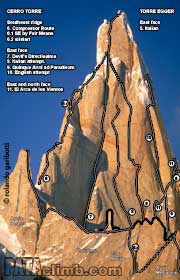
Cerro Torre southeast face 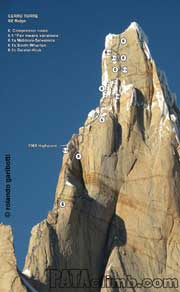
Cerro Torre southeast face 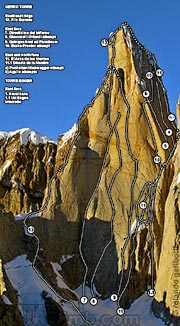
Cerro Torre east face
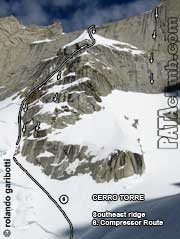
Cerro Torre southeast face 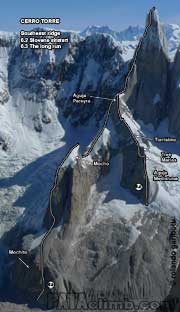
Cerro Torre east face
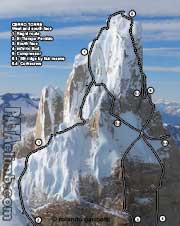
Cerro Torre southwest face |





